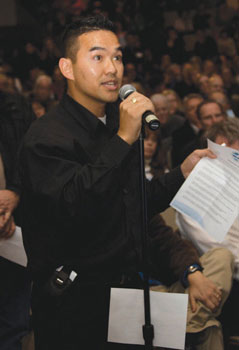Tension over the wind farm project seems to be reaching a breaking point in the Guildwood community.
A thousand people flooded into an information session hosted by Toronto Hydro at Sir Wilfred Laurier Collegiate Institute on Nov. 24 where they debated the positive and negative effects of the proposed offshore wind farm.
 |
During the question and answer session, some residents presented their concerns over possible damage to migrating birds, the lake view and property values in their area.
But others were enthusiastic about the economic benefit and the increase in employment opportunities.
“This research project can enhance the potential job market and support the future generation,” said Carolyn Egan, president of the United Steelworkers Toronto Area Council.
“We should consider very seriously about local procurement. We want jobs and benefits for our members of Scarborough.”
The first phase of this project is to install a wind monitoring station (an anemometer), to conduct wind testing at two to four kilometres off the shore of the Scarborough Bluffs and determine if it is feasible to construct up to 60 turbines in the lake.
A unique, 25-kilometre-long shallow reef from Ajax to the Leslie Spit would facilitate the installation of the wind farm, officials say.
Toronto Hydro is expecting to start the operation from next summer and collect data of wind energy resources for two years.
The Nov. 24 discussion turned into a debate about who matters the most in the community.
Local environmentalists who support the wind farm project argue it impacts all residents in Toronto, not just the people in the local community, since it relates to the issue of climate change.
“I am here on behalf of the Planet Earth,” said Chaitanya Kalevar, a member of the Canadian Action Party and a resident of Pickering. “Global warming is a global issue and not just the matter in Scarborough.”
They were frequently disturbed by local residents who oppose the project, some of whom frequently yelled “Do you live here?”
Vy Hoang, a member of the Toronto Waterfront Wind Watch, criticized the environmental groups for flooding the meeting with members.
“Stand up, Scarborough,” Hoang said.
“People of Scarborough should understand that this will completely affect the community. The Green people and people they bus in are taking your opportunity to ask the questions.”
Paul Ainslie, Scarborough East councillor, requested Toronto Hydro organize an additional meeting session only for local residents, since most of the community did not get the chance to ask questions during the four hour meeting.
“Residents’ questions should be addressed in our ward,” Ainslie said. “My residents would like to be informed of what will be taken place in the project.
“They would like to ask questions without being put on a time limit, without having to be worried about being heckled by people outside the community.”
Toronto Hydro agreed to arrange an additional meeting with representatives in the community on another day.

Over the years, I’ve witnessed those who are the biggest cheerleaders on wind energy are generally the least informed. It’s easy to jump on the green bandwagon with absolutely no critical thinking involved.
Massive industrial wind developments are being pushed by the Ontario government with absolutely no guidelines or restrictions in place to protect people and wildlife. The “environmental” review consists of company-paid people doing their own scanty research and the government rubberstamping every project to date with no full environmental review.
The developers claims are wildly exaggerated and the Ontario government has relied on CanWEA (an energy lobbyist group) for all their information. This is a tax payer boondoggle of incredible proportions and these projects will do nothing to reduce CO2. They will only increase consumption of natural gas which is needed at all times when the wind isn’t blowing (75% of the time).
See the OTHER side of the story: http://windconcernsontairo.wordpress.com